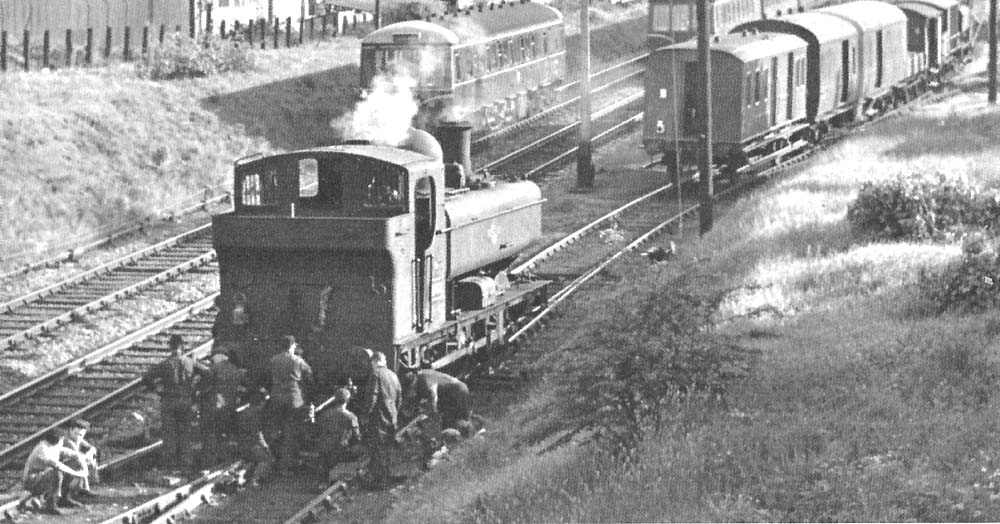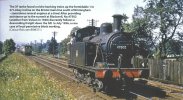-
Welcome to this forum . We are a worldwide group with a common interest in Birmingham and its history. While here, please follow a few simple rules. We ask that you respect other members, thank those who have helped you and please keep your contributions on-topic with the thread.
We do hope you enjoy your visit. BHF Admin Team -
HI folks the server that hosts the site completely died including the Hdd's and backups.
Luckily i create an offsite backup once a week! this has now been restored so we have lost a few days posts.
im still fixing things at the moment so bear with me and im still working on all images 90% are fine the others im working on now
we are now using a backup solution
You are using an out of date browser. It may not display this or other websites correctly.
You should upgrade or use an alternative browser.
You should upgrade or use an alternative browser.
Steam Locos
- Thread starter Bernard67Arnold
- Start date
Pedrocut
Master Barmmie
“Some engines in the late production batches of LMS'"Class Fives'; built after1945, embodied experimental features. No. 44687, photographed at Birmingham New Street, was fitted with Caprotti valve gear instead of the Walschaerts valve gear of the rest of the class, and also a double chimney and blast pipe.”
British Steam Locomotives by Ross, David. (2014)
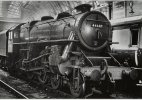
British Steam Locomotives by Ross, David. (2014)

Pedrocut
Master Barmmie
Class "5' 45324 awaiting departure at New Street with the 3.55pm to the East Coast on 29 July 1961. In the view of Brian Clarke this was the finest of all the 'Black 5s' on which he worked, although it was never allocated to 3E. Here it is a Rugby engine but Monument Lane men are on the footplate and will work through to Rugby. (D Forsyth/P Chancellor collection.)
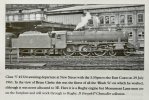

Pedrocut
Master Barmmie
The Lickey Bankers history includes subsequent locomotives after LMS was scrapped 1956.
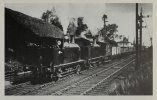
“Between Bamt Green and Blackwell stations lies the famous 300 ft. Lickey Incline. To climb this slope trains required the assistance of extra engines knoum as Bankers.”
A Postcard from the Lickeys, by JOE & FRANCES BRANNAN (1989)
Good to see pictures of the "Lickey bankers" as this was always an interesting operation to watch.
My father (who grew up in Northfield) told me about the "Decapod" which was used for banking Lickey. Also known as Big Bertha or Big Emma. At the time it was the only 10-coupled loco in service in Britain and covered hundreds of thousands of miles between 1919 and 1956 pushing trains up the Lickey incline. I believe it remains the British non-articulated loco with the highest tractive effort at 43,300 lbs. It was a 4 cylinder machine and had a huge low-speed "shove" but because it only had 2 sets of valves for 4 cylinders, it ran "out of breath" at any sort of speed.
Various locos were tried out to replace it after it was deemed to be worn out. There were two articulated Garratt type locos which were tried and found wanting, and eventually they settled on one of the latest BR Class 9 freight locos, no 92079. They were very strong, but even they had a lower tractive efforrt than Big Bertha, being only 39970 lbs.
As a young teenager in about 1962, I had a wonderful afternoon watching trains being banked up Lickey and seeing the down trains trying to hold themselves back. Also seeing the returning banking engines coming back down the hill. There was a very strict regime about getting the bank locos back to the bottom of the hill for their next turn of duty.
It has to be said that it was avery labour-intensive operation, because there was also a small fleet of 0-6-0 tank engines which took their turns in banking duties. Snag was it took 2 tank locos to do what Big Bertha did, and consequently 2 sets of crew. Very good to watch but it must have been costly in wages (and fuel) for BR!
This routine is covered very well in an old episode of "Railway Roundabout" a splendid documentary produced for BBC back about 1960, and this can be found on Youtube.
My father (who grew up in Northfield) told me about the "Decapod" which was used for banking Lickey. Also known as Big Bertha or Big Emma. At the time it was the only 10-coupled loco in service in Britain and covered hundreds of thousands of miles between 1919 and 1956 pushing trains up the Lickey incline. I believe it remains the British non-articulated loco with the highest tractive effort at 43,300 lbs. It was a 4 cylinder machine and had a huge low-speed "shove" but because it only had 2 sets of valves for 4 cylinders, it ran "out of breath" at any sort of speed.
Various locos were tried out to replace it after it was deemed to be worn out. There were two articulated Garratt type locos which were tried and found wanting, and eventually they settled on one of the latest BR Class 9 freight locos, no 92079. They were very strong, but even they had a lower tractive efforrt than Big Bertha, being only 39970 lbs.
As a young teenager in about 1962, I had a wonderful afternoon watching trains being banked up Lickey and seeing the down trains trying to hold themselves back. Also seeing the returning banking engines coming back down the hill. There was a very strict regime about getting the bank locos back to the bottom of the hill for their next turn of duty.
It has to be said that it was avery labour-intensive operation, because there was also a small fleet of 0-6-0 tank engines which took their turns in banking duties. Snag was it took 2 tank locos to do what Big Bertha did, and consequently 2 sets of crew. Very good to watch but it must have been costly in wages (and fuel) for BR!
This routine is covered very well in an old episode of "Railway Roundabout" a splendid documentary produced for BBC back about 1960, and this can be found on Youtube.
mw0njm.
A Brummie Dude
Up Special to Cadbury's, Bournville on Lickey Bank. View southwards, towards Bromsgrove, Worcester, Gloucester and Bristol; ex-Midland main line from Birmingham, Derby etc. All ascending trains, with bankers, made a fine sight and sound. One might have thought BR should have provided a clean engine for this Special. It is Stanier Class 5 4-6-0 No. 44813 (built 1944, not withdrawn until 2/68

source
Ben Brooksbank,

source
Ben Brooksbank,
Last edited:
This was an occasion which was documented in the Railway Magazine in (IIRC) 1955. An LMS 2-6-6-2 Garratt was at the head of the heavy freight train and the LNER 2-8-8-2 Garratt was being trialled as a banker on Lickey. Unfortunately the U1 ran into trouble and Big Bertha was summoned to assist.LNER Garratt, the U1 banking a train up the Lickey incline together with former Midland Railway and later LMS banker; Big Bertha........year unknown
image, BrawlMasterDani
I suspect this could represent a record for the greatest amount of tractive power ever applied to a train in the UK!
Theoretically the U1 should have been at least equal to Big Bertha and another tank engine, but in practice the crews found it difficult to work with. Not knowing where the end of the loco was proved a problem on at least one occasion when she buffered up behind a passenger train too quickly and caused a lot of damage.
The task for which the U1 was designed had been overtaken by electric traction and they were trying to find a use for it. Sadly as a Lickey banker she was not a success and was quietly withdrawn and scrapped in about 1956-7.
mw0njm.
A Brummie Dude
thank you for that very interesting readingThis was an occasion which was documented in the Railway Magazine in (IIRC) 1955. An LMS 2-6-6-2 Garratt was at the head of the heavy freight train and the LNER 2-8-8-2 Garratt was being trialled as a banker on Lickey. Unfortunately the U1 ran into trouble and Big Bertha was summoned to assist.
I suspect this could represent a record for the greatest amount of tractive power ever applied to a train in the UK!
Theoretically the U1 should have been at least equal to Big Bertha and another tank engine, but in practice the crews found it difficult to work with. Not knowing where the end of the loco was proved a problem on at least one occasion when she buffered up behind a passenger train too quickly and caused a lot of damage.
The task for which the U1 was designed had been overtaken by electric traction and they were trying to find a use for it. Sadly as a Lickey banker she was not a success and was quietly withdrawn and scrapped in about 1956-7.
mw0njm.
A Brummie Dude
interesting reading for some
Radiorails
master brummie
I don't need to read about it, I was travelling around the South Devon lanes - and frequently digging my self out of snow drifts in 1963.
A friend in North Devon was worse off, he had his food dropped by helicopter due to his remote location!
Not much snow in those photos by the way.
A friend in North Devon was worse off, he had his food dropped by helicopter due to his remote location!
Not much snow in those photos by the way.
Out in the sticks Brummy
master brummie
My idea of heaven chocolate and steam trainsUp Special to Cadbury's, Bournville on Lickey Bank. View southwards, towards Bromsgrove, Worcester, Gloucester and Bristol; ex-Midland main line from Birmingham, Derby etc. All ascending trains, with bankers, made a fine sight and sound. One might have thought BR should have provided a clean engine for this Special. It is Stanier Class 5 4-6-0 No. 44813 (built 1944, not withdrawn until 2/68

source
Ben Brooksbank,
mw0njm.
A Brummie Dude
mine tooMy idea of heaven chocolate and steam trains
Out in the sticks Brummy
master brummie
man after my own heartmine too
Bob Davis
Bob Davis
And it would have its own CUPling for hot chocolate when it is running. All aboardA chocolate loco 34 metres long has entered Guinness World Records
The train weighs 1,285 kilograms, and officials confirmed that the entire 34.05-metre length was made only of chocolate.
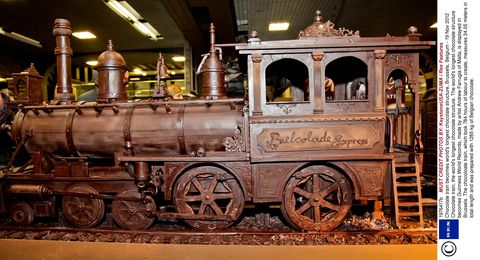
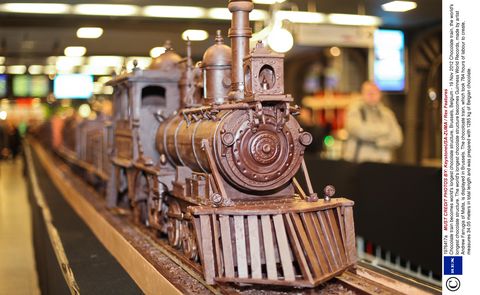
Ɓob
mw0njm.
A Brummie Dude
Belgian ChocolateLooks american, so dod it taste like chocolate or like Hersheys
mw0njm.
A Brummie Dude
wonder if it uses chocolate logs
 www.amusingplanet.com
www.amusingplanet.com
34-metre Model Train Made Entirely From Chocolate
mikeflan
master brummie
We used to get some good kops on the Cadbury's Specials and strange things would happen....we used to get LNER B1's allowed to come all the way through to Bournville and carriage stocks were allowed from Southern region, always clean locos too on the Specials........they were good days back then.Up Special to Cadbury's, Bournville on Lickey Bank. View southwards, towards Bromsgrove, Worcester, Gloucester and Bristol; ex-Midland main line from Birmingham, Derby etc. All ascending trains, with bankers, made a fine sight and sound. One might have thought BR should have provided a clean engine for this Special. It is Stanier Class 5 4-6-0 No. 44813 (built 1944, not withdrawn until 2/68

source
Ben Brooksbank,
Lloyd
master brummie
It would melt if they lit the boiler! Leaves on the line are bad enough, but sticky chocolate? Ha!wonder if it uses chocolate logs
34-metre Model Train Made Entirely From Chocolate
www.amusingplanet.com
Pedrocut
Master Barmmie
“Station pilot duties at Birminghan (Snow Hill) were more often than not performed by tender locomotives, usually from 84E Tvseley. This is the case on an unknown day in 1958 where we find GWR Modified Hall Glass 4:6:0 No 7912 Little Linford Hall at work in the up main platform. A popular resident of Tyseley, Little Linford Hall was drafted to 84C Banbury in April 1962 being condemned trom there in October 1965.“ (RS Carpenter)
British Railways steaming through the fifties by Hands, Peter (1993)
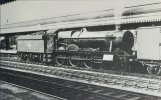
British Railways steaming through the fifties by Hands, Peter (1993)




